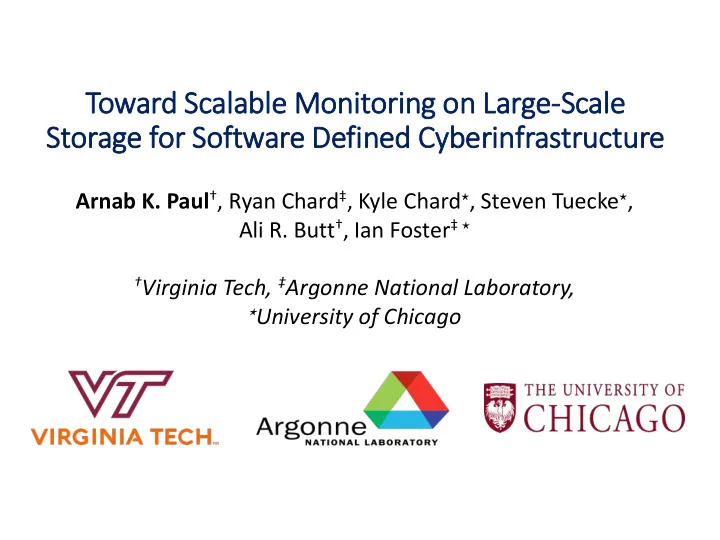

Toward S Scalable M Monitoring on L Large-Sc Scale e Storage for S Softw tware D Defi fined Cyb yberinfrastr tructu ture Arnab K. Paul † , Ryan Chard ‡ , Kyle Chard ⋆ , Steven Tuecke ⋆ , Ali R. Butt † , Ian Foster ‡ ⋆ † Virginia Tech, ‡ Argonne National Laboratory, ⋆ University of Chicago
Motivation Data generation rates Complex analysis The data lifecycle often are exploding processes involves multiple organizations, machines, and people 2
Motivation This creates a significant strain on researchers • Best management practices (cataloguing, sharing, purging, etc.) can be overlooked. • Useful data may be lost, siloed, and forgotten. 3
Sof oftware D Defin ined C Cyberin infr frastruct cture ( (SDCI) Accelerate discovery by automating research processes, such as data placement, feature extraction, and transformation. Enhance reliability, security, and transparency by integrating secure auditing and access control mechanisms into workflows. Enable data sharing and collaboration by streamlining processes to catalog, transfer, and replicate data. 4
Backgroun und: d: R R IPPLE LE R IPPLE : A prototype responsive storage solution Transform static data graveyards into active, responsive storage devices • Automate data management processes and enforce best practices • Event-driven: actions are performed in response to data events • Users define simple if-trigger-then-action recipes • Combine recipes into flows that control end-to-end data transformations • Passively waits for filesystem events (very little overhead) • Filesystem agnostic – works on both edge and leadership platforms 5
R IPPL PLE Archi hitecture Agent: Service : - Sits locally on the machine - Serverless architecture - Detects & filters filesystem events - Lambda functions process events - Facilitates execution of actions - Orchestrates execution of actions - Can receive new recipes 6
R IPPL PLE Rec ecip ipes IFTTT -inspired programming model: Triggers describe where the event is coming from (filesystem create events) and the conditions to match (/path/to/monitor/.*.h5) Actions describe what service to use (e.g., globus transfer) and arguments for processing (source/dest endpoints). 7
R IPPL PLE Agent Python Watchdog observers listen for events - inotify , polling, for filesystem events (create, delete, etc.) Recipes are stored locally in a SQLite database 8
Li Limitati tions • Inability to be applied at scale • Approach primarily relies on targeted monitoring techniques • inotify has a large setup cost • time consuming and resource intensive • Crawling and recording file system data is prohibitively expensive over large storage systems. 9
Scalabl ble Moni nitoring • Uses Lustre’s internal metadata catalog to detect events. • Aggregate the events and stream those to any subscribed device. • Provides fault tolerance. 10
Lustre Changelog • Sample changelog entries • Distributed across Metadata Servers (MDS) • Monitor all MDSs 11
Moni nitoring A Architecture 12
Moni nitoring A Architecture ( (contd. d.) • Detection • Collectors on every MDS • Events are extracted from the changelog. 13
Moni nitoring A Architecture ( (contd. d.) • Detection • Collectors on every MDS • Events are extracted from the changelog. • Processing • Parent and target file identifiers (FIDs) are not useful to external services. • Collector uses Lustre fid2path tool to resolve FIDs and establish absolute path names. 14
Moni nitoring A Architecture ( (contd. d.) • Aggregation • ZeroMQ used to pass messages. • Multi-threaded: • Publish events to consumers • Store events in local database for fault tolerance 15
Moni nitoring A Architecture ( (contd. d.) • Aggregation • ZeroMQ used to pass messages. • Multi-threaded: • Publish events to consumers • Store events in local database for fault tolerance • Purging Changelog • Collectors purge already processed changelog events to lessen the burden in MDS. 16
Evaluati tion Testbeds • AWS • 5 Amazon AWS EC2 instance • 20 GB Lustre file system • Lustre Intel Cloud Edition 1.4 • t2.micro instances • 2 compute nodes • 1 OSS, 1 MGS, and 1 MDS 17
Evaluati tion Testbeds • IOTA • Argonne National Laboratory’s Iota cluster • 44 compute nodes • 72 cores • 128 GB memory • 897 TB Lustre Store ~ 150 PB for Aurora 18
Testbe bed Performance AWS IOTA Storage Size 20GB 897TB Files Created (events/s) 352 1389 Files Modified (events/s) 534 2538 Files Deleted (events/s) 832 3442 Total Events (events/s) 1366 9593 19
Event T Throughput AWS IOTA Storage Size 20GB 897TB Files Created (events/s) 352 1389 Files Modified (events/s) 534 2538 Files Deleted (events/s) 832 3442 Total Events (events/s) 1366 9593 • AWS • Report 1053 events per second to the consumer. • IOTA • Report 8162 events/s 20
Moni nitor Overhe head CPU (%) Memory (MB) Collector 6.667 281.6 Aggregator 0.059 217.6 Consumer 0.02 12.8 Maximum Monitor Resource Utilization 21
Scaling P Performance • Analyzed NERSC’s production 7.1PB GPFS file system • Over 16000 users and 850 million files • 36-day file system dumps. • Peak of 3.6 million differences between two days • ~ 127 events/s • Extrapolate to 150PB store for Aurora • ~ 3178 events/s 22
Conclusion • SDCI can resolve many of the challenges associated with routine data management processes. • R IPPLE enabled such automation but was not often available on large-scale storage systems. • Scalable Lustre monitor addresses this shortcoming. • Lustre monitor is able to detect, process, and report events at a rate sufficient for Aurora. 23
akpaul@vt.edu http://research.cs.vt.edu/dssl/ 24
Recommend
More recommend